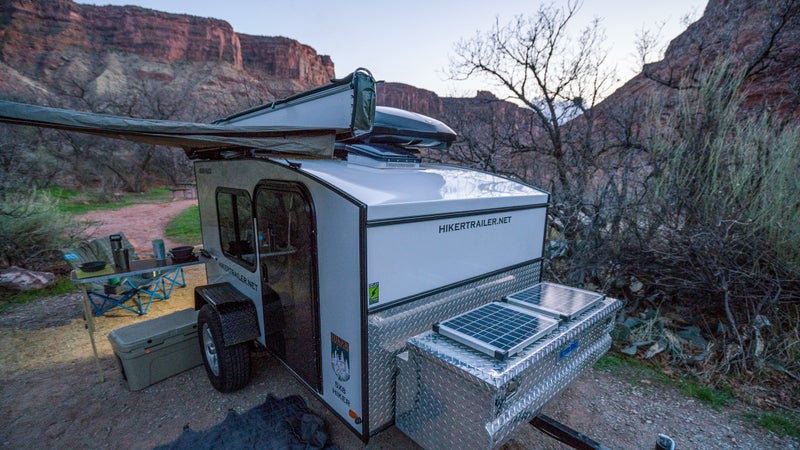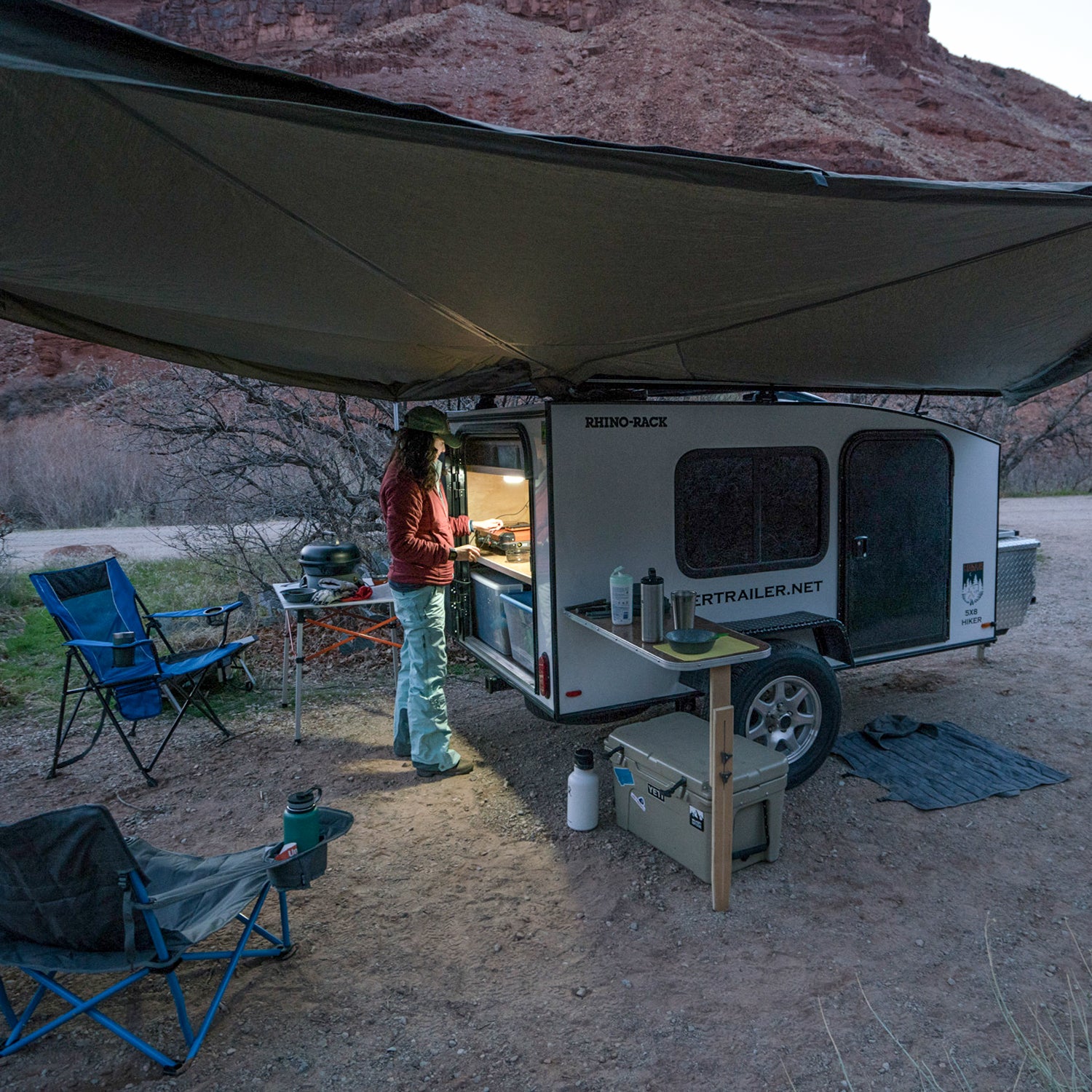I, like many of you, dream about owning a tricked-out Sprinter or Tacoma and living on the road. But that’s not possible with a full-time job and limited funds. So I’ve been exploring alternative options for weekend adventuring.
Most recently, I came across Hiker Trailer, a company that makes well-built and surprisingly affordable teardrop-style towables. Instead of the outrageous $20,000 price tag you see on many teardrops, its trailers are usually well under $10,000—and often in the $5,000 range. Curious to see how well one worked, I called the company and asked for a demo. My wife and I have been using it for the past three months.
Driving
I first found Hiker Trailer at last year’s Overland Expo West, and its headquarters is in Denver, Colorado. In February, my wife and I visited while en route to Jackson Hole and picked up the demo. (There’s now a rental program, too, so you can try before you buy.) We tested a five-by-eight-foot Deluxe model , which is the mid-tier and most popular option. It costs $4,700 for the base and weighs 780 pounds, so you can tow it with a Subaru. However, our demo came with several additional goodies—solar panels, an awning, a heavy-duty axle, a rear galley-style door, and roof rack components—which drove the weight up to 1,300 pounds and the price up to about $9,000.
On the road, the trailer was simple to pull, just like a small U-Haul. There was zero fishtailing, and because I drive a Toyota Tundra, which has a large towing capacity, we often forgot we had a trailer attached to the back. The only caveat: we did find it hard to back up. The Deluxe is fairly long for its size and can jackknife due to its single axle. That said, if you get into a backup bind, you can unhitch the trailer and move it easily by hand.
Exterior

The rear swing-out door on our model opens up to reveal enough storage for a tricked-out camp kitchen plus several Rubbermaid bins. Below that door there’s an integrated receiver hitch, where we attached a Thule bike rack for a long weekend of mountain biking in Utah.
Up top we also had a roof box and racks where we hauled our skis on the way to Jackson. Both of those sat on a Rhino Rack Pioneer Platform, which also held a Rhino Rack Foxwing swing-out awning that provides 270 degrees of protection. Our Foxwing came with the Tapered Zip Extension accessories, so we had zip-on tent walls that hung down from the awning and effectively tripled our living space. The awning and walls held up well to rain, and the awning itself created a lot of shade during sunny afternoons in the desert.
For solar, we had two 20-watt Zamp panels mounted to the trailer’s front storage box and another 40-watt portable Zamp panel kit that we could deploy at camp. All the panels hooked up to an inverter and charged a battery that ran the trailer’s electrical system.
Interior

The five-by-eight-foot queen-size bed in our trailer came with a four-inch memory-foam mattress that was almost as comfy as our bed at home. With a down quilt and some sheets, plus a small portable space heater, we stayed warm while camping in snow and near-freezing temperatures in Montana, Utah, and Arizona, despite the lack of insulation in the walls. The trailer and doors are sealed incredibly well to keep out the elements, so it’s important to crack a window or run the included venting fan at night. While it isn’t intended to be a winter camper, you can make it work in cold temperatures. It’s certainly nicer than a tent.
There are integrated lights in the rear hatch and above the bed that run off the solar panels and the included car battery. It was nice to flip a switch and be able to cook at night or read before bed without having to fumble with a headlamp. There’s also a power strip in the rear hatch and USB ports above the bed, both of which made charging gadgets like phones, cameras, and computers a breeze. We never drained the battery when just charging gadgets, but we did run the battery dry one night by using the space heater. If you’re in a campsite with an electricity hookup, the electrical system can be plugged in.
The Competition
There are a lot of other high-quality camping trailers out there, from off-road expedition-style trailers like the Moby XTR that starts at $18,500 to the Airstream Sport 16' that starts at $44,383. But in terms of amenities and intended use, the closest competitors to Hiker Trailer are Colorado Teardrops Basedrop, Timberleaf Camping Trailer, Sylvan Sport Go, So-Cal Teardrops 509 Sierra, and American Teardrop Falcon. The average base price of those trailers is $12,031, and only the American Teardrop Falcon comes anywhere close to the Hiker, with a starting price of $7,445. None of these trailers offer much more in the way of amenities (like a sink, standing room) than the model we tested, and in some cases, they offer less. The Sylvan Sport Go is an innovative, super-cool camping and gear-hauling trailer, but at $9,995 you don’t even get hard-sided walls. And while it’s true that a Hiker Trailer’s price can add up quickly when you start adding accessories like a solar-powered electrical system, roof rack, and custom cabinetry, that’s the case with all of these brands as well.
Should You Buy One?
While testing, I was constantly trying to figure out where the Hiker fits into the long list of adventure-vehicle options outside of its immediate competitors. If you already own a truck, something like a slide-in camper from 4WheelCampers could be more versatile and give you some additional living space (with room to stand), but you’re going to spend a lot more there as well. A camper shell and a sleeping platform or rooftop tent will give you a lot of the benefits of a Hiker Trailer, albeit with fewer amenities and less storage space.
Here’s what finally sold me: the organization and ease of use. My wife and I left our demo full of camping gear and parked in our driveway, ready to go at a minute’s notice. That’s not something you can do with a truck and rooftop tent, where to need to reload all your bedding and camping supplies. You could, in theory, leave a fully packed slide-in on your truck, but that would eat gas. You could also build out a camper van, but then you’ve got another vehicle to maintain.
More simply put, if you want to camp a lot, want a setup that’s easy to use and pull, and don’t want to take out a second mortgage, there’s currently no better option.

